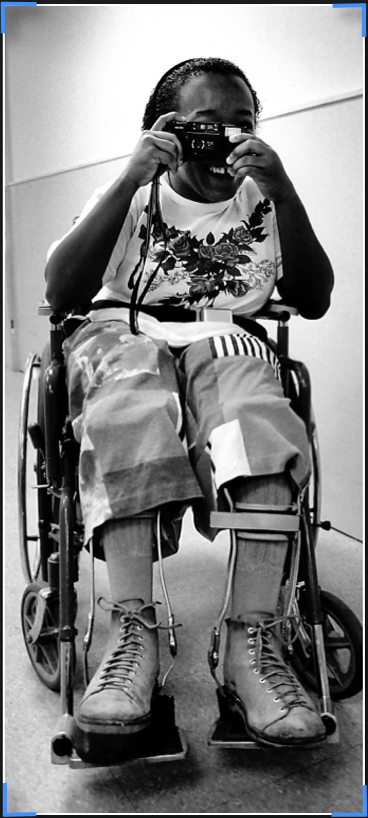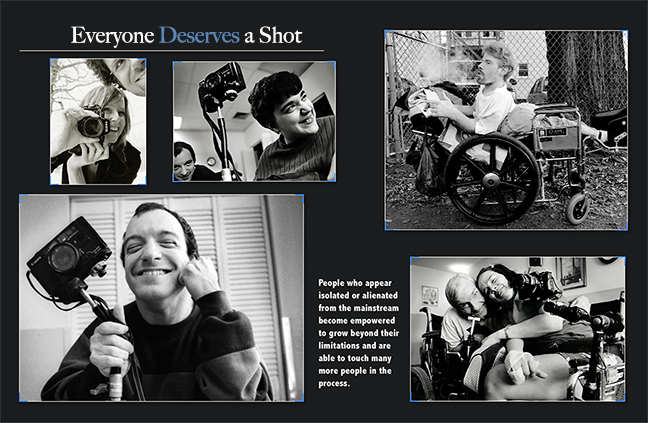Activist for People with Disabilities
Courtney Bent is a Life Changer
by Matt Kramer
Many articles are written about people who touch the lives of others in healing, loving and heartfelt ways. Photographer/filmmaker Courtney Bent goes miles further. In her work, people who appear isolated or alienated from the mainstream become empowered to grow beyond their limitations and are able to touch many more people in the process. On the surface, Bent accomplishes this by sharing her expertise and passion for photography, inventing ways for even the most disabled to be able to handle the camera and take a picture. Her drive is fueled by a love for people and joy in watching others blossom as they learn to use the camera to share their inner world.
Bent has also worked with at-risk teenage girls. She has seen girls who appeared completely shut down… open up, transform their lives and earn scholarships to study photography. When asked about her experience working with the girls, she replied, “It was an honor to feel like I could guide someone to find a way to express themselves when, for so long, their life situation was so challenging.”
Bent was born into a fashion-conscious family; both parents worked in aspects of the fashion industry. As early as eight years old, looking at a child leaning out of a window, Bent remembers seeing life in terms of images, wishing she had a camera to catch that moment. She still treasures a photo of a couple on a Harley Davidson she took from the back seat of her parents’ car at the age of fourteen.
Bent’s father and grandfather were enthusiastic photographers; cameras were always available and accessible. While it was easy to follow their path, which she did early in her career as a fashion photographer, she never really felt at home in the rarified world of fashion. In her experience, the fashion industry’s concept of beauty often misses the beauty of real people, their goodness, who they are and the magic in the ways they interact with each other.
Bent’s transition from fashion photog to her life as a teacher and arts activist for people with disabilities, began as a project to photograph the folks who attended a cerebral palsy day program. The project was supposed to last a few weeks but evolved beyond the photographer/subject relationship, into friendships that have now lasted for years. The transition began when Bent realized that the photos she was taking were dark and missing the vibrant life that she was beginning to experience in this new community. In her words, “The photographs I was getting were not what I was feeling at that moment. I was feeling their humanity but it wasn’t coming across.”
As she puzzled over her photos, it became clear to her that she had to switch the roles and help her subjects take their own photos. Because many of them had limited or had no control of their arms or hands, Bent invented ways for them to use the camera. She created rigging to attach to the wheelchairs and added or invented various kinds of buttons to make the cameras usable. In some cases, a large and strategically designed button made the cameras workable for those who were paralyzed from the neck down and could only move their tongues. Bent explained, “I love adapting cameras for people with disabilities. It’s amazing to be able to be with someone the moment they take their very first picture.”
The photo project became an award-winning documentary, Shooting Beauty, that Bend produced with her husband and director, George Kachadorian. The film has become successful in a number of ways, most notably in how it has opened the eyes and hearts of its audience. Tony Knight, one of the stars featured the movie, filmed his travels through crowds on his motorized wheelchair, catching the strained reactions and non-reactions of the passersby. Learning to use a camera has transformed Knight’s life; he now sets up his own photography exhibits.

The film has been so moving and insightful that it is now being used in schools and corporations to help teach diversity and tolerance. Bent remembers being nervous at the first such screening in Durham, NC. Teachers around the city had been invited to bring their classes for free; about a thousand middle and high school students were in the audience. As the film began, a teacher, not knowing she was sitting next to the director, confided, “My kids will never sit still through this.”
At the end of the film, Bent and Knight came onstage to talk about the film. The kids yelled, cheered and jumped to their feet chanting Tony’s name; afterward many of them came and hugged Knight and had their photos taken with him. Bent describes the moment; “It was like nothing we had ever experienced. Tony’s disability was no longer the first thing these kids saw. They truly wanted to embrace Tony for being Tony, the inspiring and cool person that he is.”
Bent’s journey with Shooting Beauty continues to take her to surprising places. She is partnering with the Girl Scouts to create a patch program based upon the principles in the film. She has also developed a school program with a curriculum that engages students in activities before and after watching the film. But she will never have the time to reach the hundreds of communities around the nation that are home to people with disabilities.
Bent invites everyone to get involved, even if only for one day, to pick up a camera, visit a center or even one person who is shut-in and isolated, and help them find a way to reach out, gain positive life skills and integrate better with the community. She encourages; “Don’t let yourself feel like you can’t do it. Don’t let your fears get in the way. Just get the camera in their hands – it’s not about expecting pictures that can be shown in National Geographic; it’s about what this opportunity can do for someone.”
Visit Courtney Bent’s website




